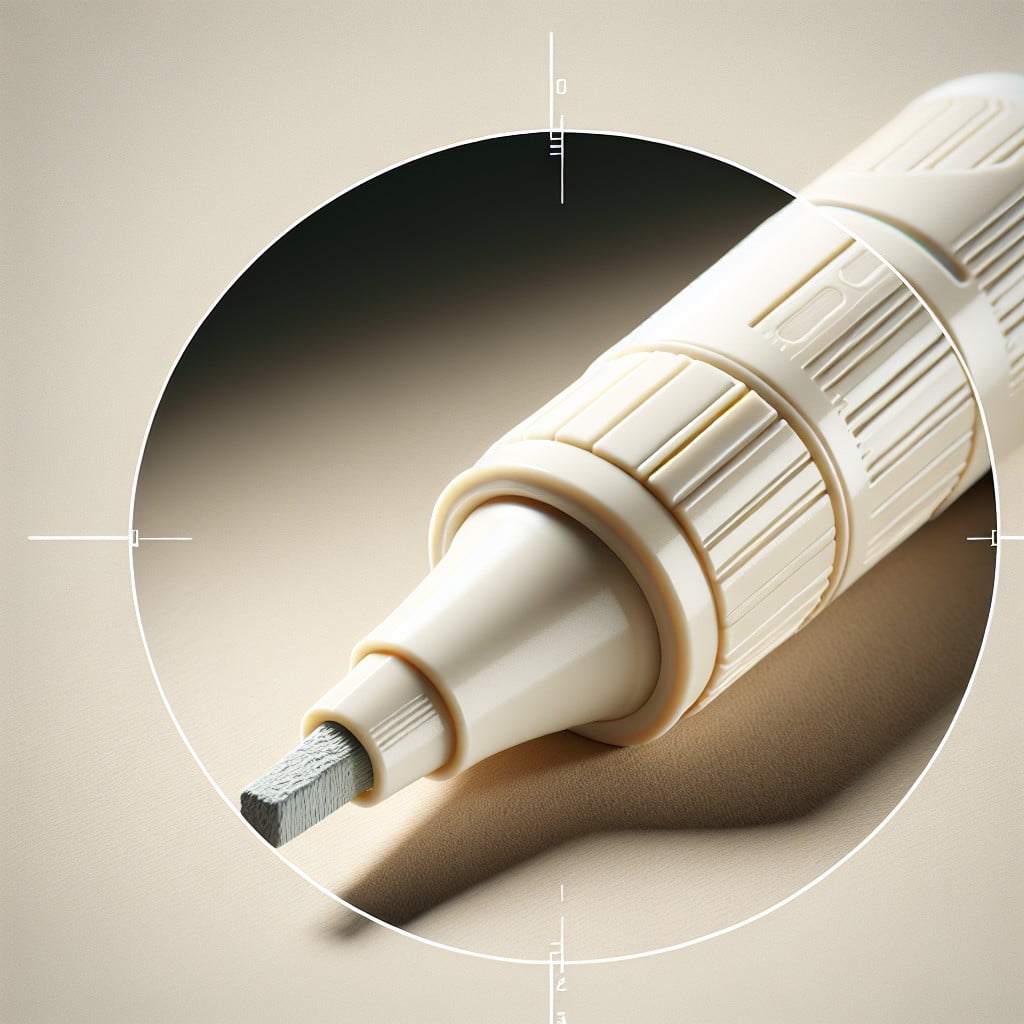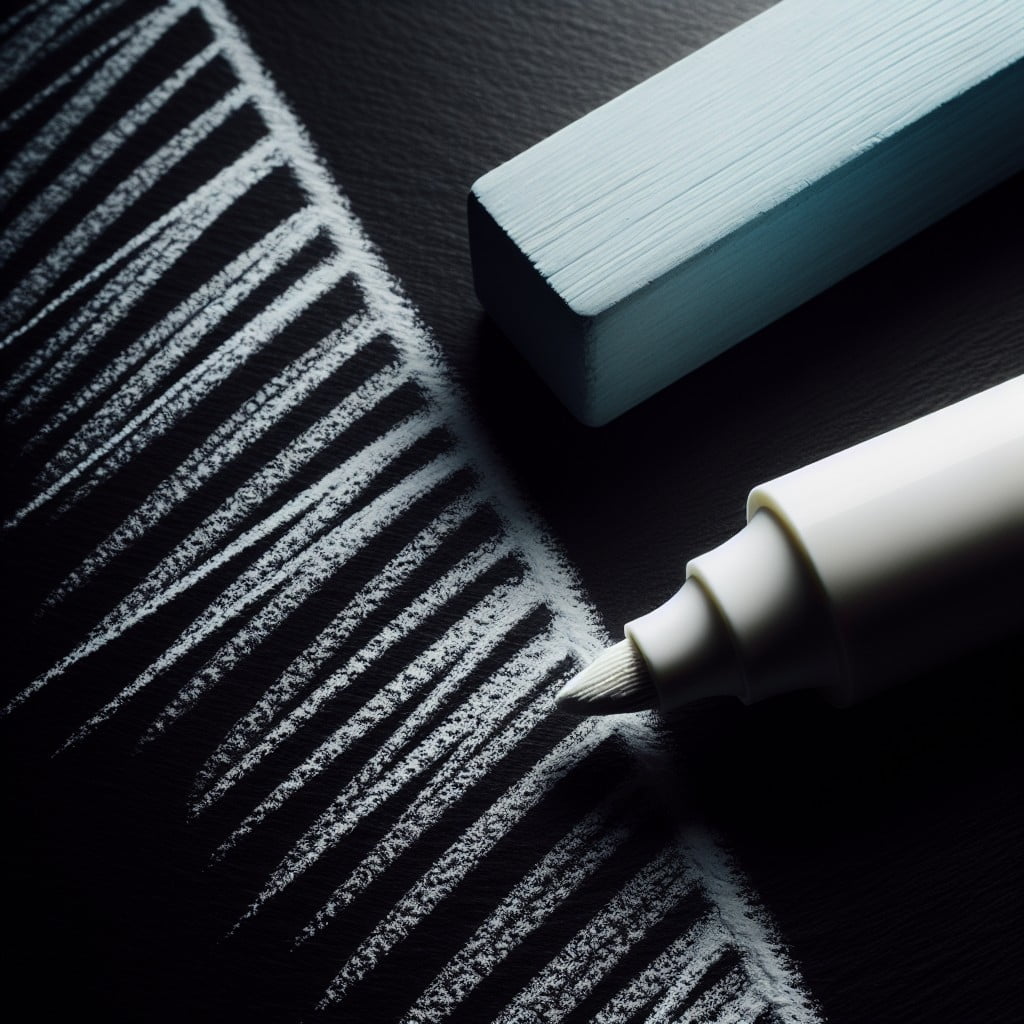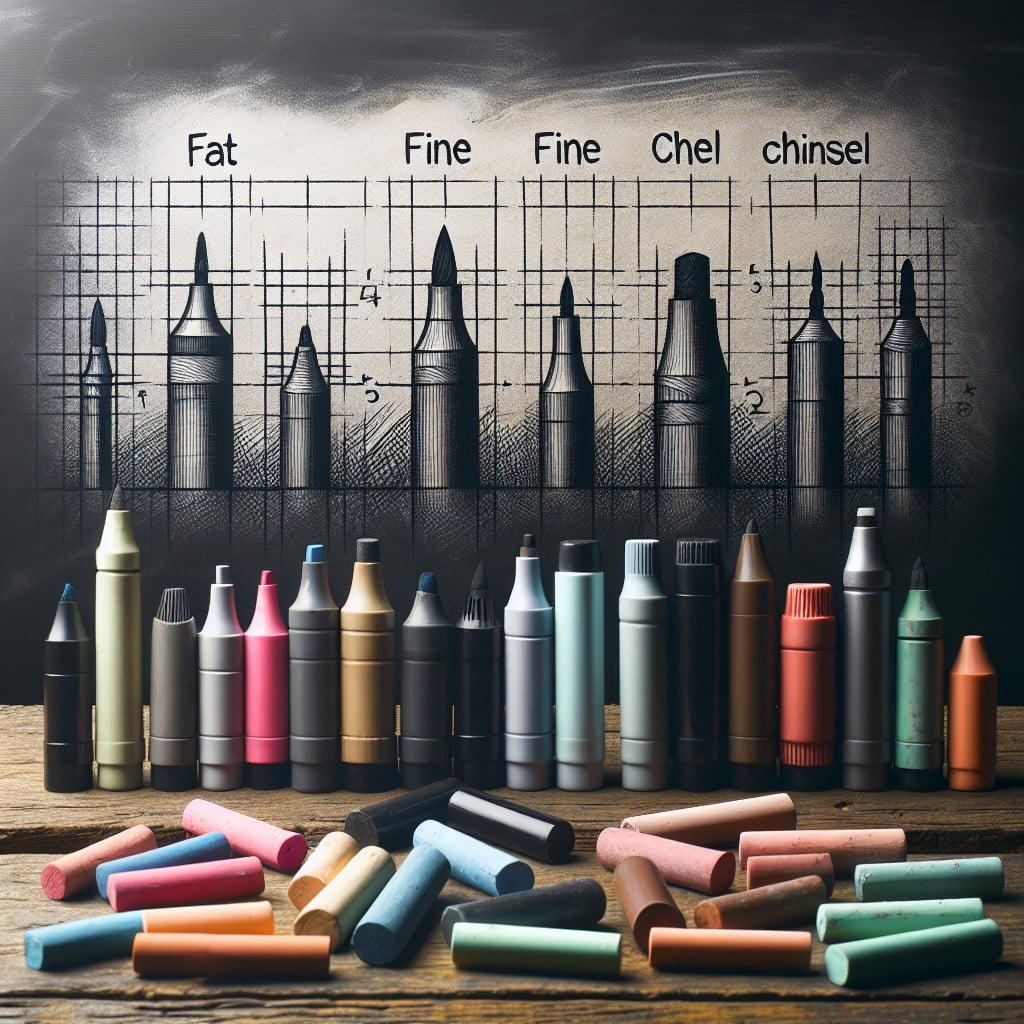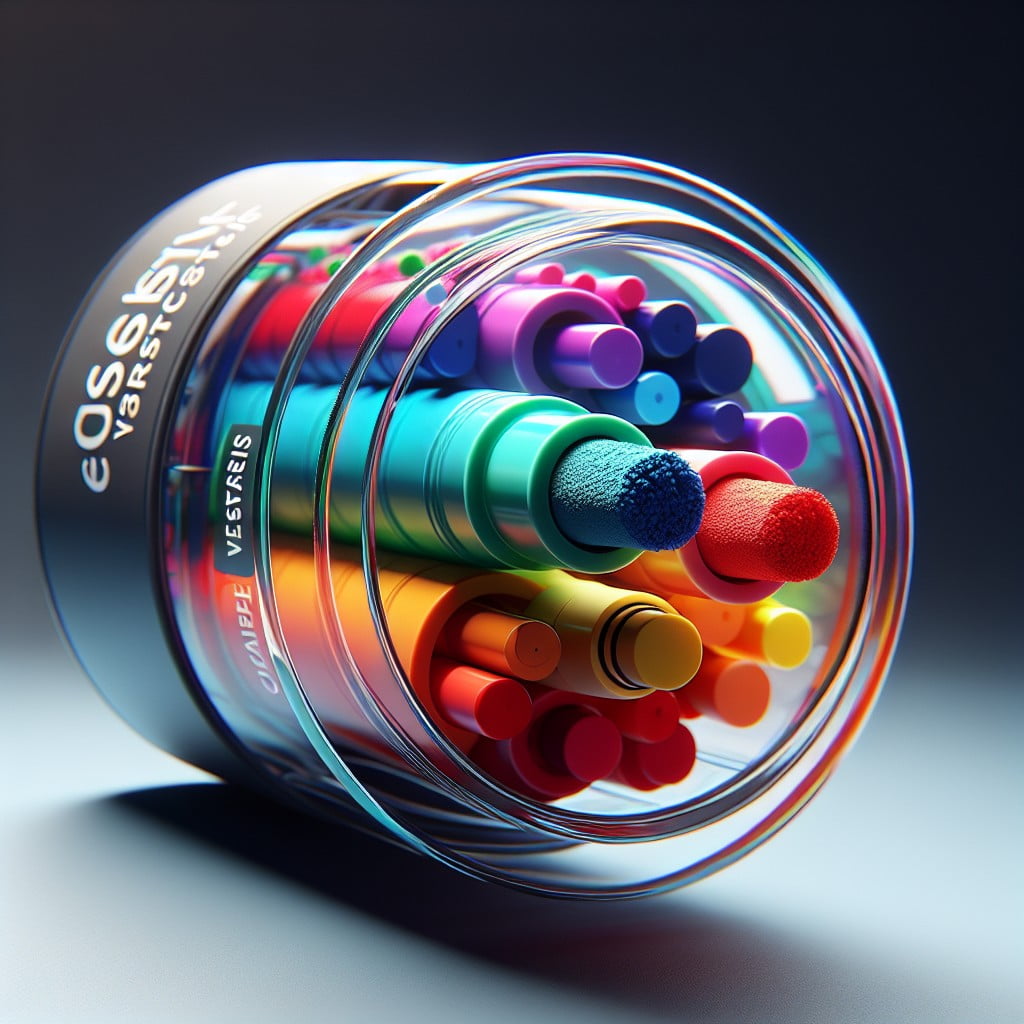Last updated on
Dive right into unlocking the world of chalk markers, as this article offers an in-depth look into what these markers are, exploring their distinct characteristics, uses, and benefits.
Key takeaways:
- Chalk markers contain water-based pigment ink for vibrant colors.
- They are reversible and can be easily wiped off with a damp cloth.
- Chalk markers come in a variety of tip sizes for different needs.
- The ink dries quickly and is non-toxic.
- Chalk markers are versatile and can be used on various surfaces.
Composition and Characteristics of Chalk Markers

Chalk markers, an innovative twist on the traditional chalk, contain a water-based pigment ink that provides vibrant, opaque colors. Unlike the dust-producing sticks of calcium sulfate we’re familiar with in classrooms, these markers deliver a smoother, more consistent application. Their liquid formulation allows the ink to flow easily onto non-porous surfaces, creating crisp lines and a paint-like finish that stands out. When dry, the resulting marks mimic the appearance of chalk without the mess, making them a popular choice for artists, teachers, and at-home use.
A noteworthy feature of these markers is their reversibility; writing and drawings can be removed with a damp cloth, facilitating easy updates and corrections. This erasability factor contributes to the versatility of chalk markers, further broadening the range of their applications from menu boards to crafts. Additionally, the quick-drying nature of the ink helps to minimize smearing, a common issue with traditional chalk.
One of the signature traits of these markers is their variety of tip sizes. They come equipped with fine tips for detailed work, broad tips for high visibility writing, and chisel tips that offer angled strokes, catering to diverse artistic and functional needs.
How Chalk Markers Differ From Traditional Chalk

Traditional chalk, made of calcium sulfate or calcium carbonate, leaves a dusty residue that can be messy and is prone to smudging. Conversely, chalk markers, containing a water-based liquid ink, provide a smooth, vibrant finish that is more likely to resist smearing once dry.
The precision offered by a marker tip allows for finer detailing, compared to the wider, less controllable lines produced by the blunt edge of a stick of traditional chalk. Chalk markers can be used on various non-porous surfaces such as glass, metal, and sealed chalkboards where they display brighter colors and greater legibility.
While traditional chalk is limited in color variation, chalk markers come in a myriad of hues, including neon and metallic shades, expanding creative possibilities.
Types of Chalk Markers and Their Tips

Chalk markers come in a variety of tip shapes and sizes to cater to different artistic preferences and project requirements. Bullet tips, commonly found in these markers, are ideal for fine lines and detailed work, while chisel tips offer the flexibility of creating both thin and thick lines, making them perfect for calligraphy and bold lettering. Brush tips mimic the feel of a paintbrush and are favored by those looking to blend colors or achieve a painterly effect.
For detailed illustrations or writing small text, fine tips provide precision. Conversely, wide tips are suited for filling large areas with color or making a bold statement on signage. Some chalk markers feature reversible tips, which can be flipped to switch between a bullet and chisel edge, offering versatility without the need to switch markers.
In understanding the diverse array of chalk marker types, consider your project’s scale, the intricacy of the design, and whether you’ll be blending colors or layering text. Each tip style influences the outcome of your artistic endeavors, and selecting the right one can greatly enhance the effectiveness of your visual communication.
The Ink in Chalk Markers

Chalk markers employ a water-based pigment ink which offers a smooth, opaque consistency, not to be confused with the powdery residue associated with traditional chalk. This type of ink enables bright, vivid colors that stand out prominently against dark surfaces, such as chalkboards and glass.
Due to its water-based nature, the ink is typically non-toxic, making it a safe choice for use by both adults and children.
Upon application, the ink dries quickly to prevent smudging, yet remains easy to wipe away with a damp cloth when it’s time for a change. The fluid ink also allows for continuous writing without needing to press hard, as one often must with traditional chalk.
One unique quality of chalk marker ink is that it is wet-erasable, meaning that once dry, it does not dust off or smear easily, providing a semi-permanent finish that can withstand the elements, especially useful for outdoor signage or car windows.
To maintain the quality of the ink and ensure its longevity, keep the cap tightly sealed when not in use to prevent the ink from drying out. Additionally, storing the markers horizontally will aid in keeping the ink flow consistent and ready for your next use.
Safety and Toxicity
Chalk markers are often lauded for their user-friendly qualities, including their safety profile. They typically contain water-based, non-toxic ink, making them safe for artists of all ages to express their creativity without the worry of harmful chemical exposure. This feature also extends to environments like classrooms and eateries, where their use is frequent.
Despite their general safety, it is always prudent to check the labels for any specific certifications such as AP (Approved Product) Seal from the Art & Creative Materials Institute (ACMI), confirming that the product is non-toxic to humans, including children. Moreover, always ensure adequate ventilation when using them for extended periods, and keep a lookout for any allergic reactions on skin contact.
In the unexpected event of ingestion, the non-toxic nature of chalk markers means the risk is minimal. However, it is advisable to follow standard procedures for accidental ingestion of any art material, including consulting a medical professional.
While markers are safe on various surfaces, it’s important to note their permanence. Certain types can be semi-permanent on porous surfaces, so careful consideration of where they are used can prevent unwanted stains or the need for vigorous cleaning. Handle them with the same care as other art supplies, keeping them out of reach of unsupervised very young children who may be prone to chewing on or misusing them.
How to Prime Chalk Markers
To ensure smooth ink flow when using new chalk markers, priming them is essential. Begin by shaking the marker vigorously with the cap on to mix the pigment evenly. Then, press the tip down on a spare piece of paper several times to bring the ink into the tip; this may take a few pumps. Be patient—it can take a minute for the ink to fully saturate the tip.
Once the color appears, test the marker on a scrap material similar to your intended surface. This helps establish consistent ink flow and prevents potential blotching on your final artwork or text. Remember, if the ink flow slows during use, give the marker another quick shake with the cap on to reinvigorate the pigment.
Appropriate Surfaces for Chalk Marker Use
Chalk markers adhere well to non-porous, smooth surfaces where they create vibrant lines that are easy to read. Here’s where they best showcase their versatility:
- Traditional chalkboards and blackboards with a non-porous finish provide an ideal canvas for chalk markers, letting you write and erase with ease.
- Glass surfaces such as windows and mirrors allow for a temporary display of artwork or informative writing, perfect for decor or functional signage in businesses and classrooms.
- Glossy ceramic tiles can be used as reusable labeling or decorative elements in kitchens and crafts.
- Metal surfaces, particularly those painted with a non-porous finish, can be used for creative or organizational purposes.
- Plastic items that are smooth and non-porous serve as great mediums for personalization through chalk marker art, labels, and design elements.
Always test a small area of the surface before committing to extensive writing or drawing. Some materials like wood may absorb the ink, making it difficult to erase.
Techniques for Using Chalk Markers
Mastering the art of using chalk markers can elevate your projects to a new level of professionalism and creativity. Begin by holding the marker at a slight angle; this position maximizes ink flow and helps avoid uneven lines. For fine details or intricate designs, use a steady hand and light pressure. Should you wish to create bold lines or fill in larger areas, apply more pressure and use the side of the tip.
Layering colors can add depth to your designs. Allow the first color to dry completely before applying a second to avoid smudging. For a blended look or to soften edges, quickly smudge the lines with a damp cloth before the ink sets.
When working with templates or stencils, ensure they are firmly in place to prevent bleeding. Also, remember that slow, deliberate strokes often yield more consistent results than rapid movements. Experiment with dotting, shading, and stroking techniques to add texture to your creations.
Lastly, don’t be afraid to make mistakes. The beauty of chalk markers lies in the ease of correction. A damp cloth can wipe away errors, leaving a clean slate for you to try again. With practice, these techniques will become second nature, allowing your chalk marker skills to flourish.
Cleaning and Removing Chalk Marker Ink
To remove ink from non-porous surfaces, a damp cloth or sponge often does the trick. For persistent marks, glass cleaner or a mix of vinegar and water can be effective. Always test cleaners on a small area first to avoid damage.
On porous surfaces like unsealed wood or paper, the ink may not be fully removable, which is why these markers are best used on non-porous boards.
If staining occurs on a chalkboard, it may need to be ‘seasoned’—rubbing the side of a regular chalk stick over the entire surface and then erasing it. This creates a fine dust layer that can prevent markers from seeping into the board’s surface.
Replace caps promptly after use to prevent the ink from drying out and to avoid unnecessary cleanup. Keep markers stored horizontally to ensure even ink distribution for the next use.
Seasoning Your Chalkboard
To ensure your chalkboard remains in top condition and to prevent ghosting – where past images faintly linger – it’s essential to season it before using chalk markers for the first time.
- Begin by rubbing the side of a regular chalk stick over the entire surface, covering it with a layer of chalk dust.
- Next, use a dry eraser or a soft cloth to distribute the dust evenly, working in a circular motion.
- Once the entire board is coated, erase it with a dry cloth or eraser. This process leaves a fine layer of chalk dust that fills any pores or imperfections on the board’s surface.
- By seasoning, you essentially create a protective layer that makes future erasing more effective. This step significantly reduces the odds of your first design becoming a permanent fixture on the board.
- It’s advisable to repeat this process occasionally, especially when you notice that the markers aren’t erasing as cleanly as before.
Remember that seasoned boards still require proper cleaning between uses, but this preparation step provides an added safeguard against stains and ghosting.
Storing and Maintaining Chalk Markers
To preserve the longevity and quality of your chalk markers, proper storage is key. Always cap the markers tightly after use to prevent the ink from drying out. Store them in a horizontal position to ensure the ink remains evenly distributed, facilitating smooth application during your next use.
Exposure to extreme temperatures can affect the markers’ performance, so aim to keep them in a cool, dry place out of direct sunlight.
If a marker tip becomes clogged or dry, you can often revive it by dipping the tip in warm water for a brief moment, then pressing it onto a scrap piece of paper to encourage the flow of ink.
In the event of frayed or worn-out tips, some chalk markers offer replaceable nibs, allowing you to maintain a sharp, clean line without having to purchase a new marker.
Remember that regular use can also help maintain marker functionality, as it prevents the ink from settling or separating. By following these practices, your chalk markers will be ready to create vibrant, smooth lines whenever inspiration strikes.
Professional Uses for Liquid Chalk Markers
Liquid chalk markers have become indispensable tools across various professional domains where clear, vibrant communication is key.
In the restaurant industry, they serve as the go-to implement for crafting eye-catching and easily changeable menu boards, allowing for daily specials to be highlighted in a manner that draws customer attention effectively.
Retail settings utilize these markers for storefront window designs, which are pivotal in advertising sales and seasonal promotions. The ability to apply bright, bold colors that are resistant to smudging yet removable makes liquid chalk a valuable asset for attracting potential shoppers.
Educational professionals find them useful for whiteboards and teaching aids, where the dust-free nature of these markers is a significant benefit for maintaining a clean, allergy-friendly learning environment.
Likewise, event coordinators employ them for signage at conferences and weddings, where elegance and readability are essential. The smooth application ensures high-quality presentation of seating charts, schedules, and directional signs.
In office environments, they enhance brainstorming sessions, with their bright colors facilitating the organization of ideas and tasks on large calendar boards or during team meetings to visualize concepts and strategies.
Corporate trainers and keynote speakers prefer these markers to emphasize key points on flipcharts and presentation boards, ensuring that important information stands out and remains front and center in the audience’s mind.
Each of these professional uses leverages the distinct advantages of liquid chalk markers: vivid colors, versatility, and ease of use, which combine to create efficient and engaging visual communication.
DIY Chalk Marker Lettering
Enhance your home decor or add a personal touch to parties and events with DIY chalk marker lettering. To get started, choose a smooth non-porous surface like a chalkboard or glass.
Begin with a simple sketch or outline of your desired lettering to serve as a guide. Hold the marker as you would a pen, but apply even pressure to ensure consistent ink flow.
Start with basic fonts and as you gain confidence, experiment with different typography styles to create more intricate designs. For more vibrant and colorful artwork, layer different chalk marker colors, allowing each to dry before applying the next.
To correct mistakes or sharpen edges, use a damp cloth or Q-tip, which can also achieve shading effects. Remember, practicing different strokes and font styles will improve your skills over time and add a creative flair to any DIY project.
Chalk Art On Windows and Mirrors
Chalk markers offer a delightful way to decorate windows and mirrors, creating everything from seasonal art to inspirational quotes.
Their water-based formula ensures they glide smoothly onto glass surfaces, producing vibrant and opaque lines that capture attention.
When working on these non-porous surfaces, you have the freedom to correct mistakes easily with a damp cloth.
For more intricate designs, use stencils or create patterns freehand.
Light colors are particularly striking on glass, standing out brightly against the transparent backdrop.
Remember to allow the ink to dry to prevent smudging and when the time comes to switch up your design, simply wipe the surface clean with a window cleaner or a vinegar-water solution.
It’s a simple method to add a personal touch to your space or to message special occasions, without a long-term commitment.
FAQ
What are chalk markers used for?
Chalk markers are primarily used for chalk lettering, chalk art, making erasable calendars, and painting on glass and other non-porous surfaces, especially by individuals who are allergic to chalk dust.
What’s the difference between a paint marker and a chalk marker?
The primary distinction lies in the permanence and color variety; paint markers provide lasting marks whereas chalk markers offer semi-permanent markings with a wider range of color options and finishes.
Are chalk markers the same as dry erase?
Chalk markers, while similar in use to dry erase markers, are distinct as they are both dry and wet-erase, offering easy removal without leaving mark residues, also known as ghosting.
How do you use chalk markers for the first time?
For the initial use of chalk markers, ensure to shake the marker with its cap on for half a minute to mix the liquid chalk, followed by gently pressing the tip against a hard surface causing it to saturate with ink, making it ready for use.
Can chalk markers be used on any surface?
Chalk markers can be used on any non-porous surface such as glass, mirrors, plastic, and ceramics.
How do you clean up or remove chalk marker ink?
To clean or remove chalk marker ink, apply a dampened cloth with any ammonia-based window cleaner on the surface, let it sit a moment, then wipe it away with a clean cloth.
Are chalk markers safe for children to use?
Yes, chalk markers are safe for children to use as they are typically non-toxic and washable.
Recap:




